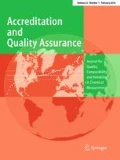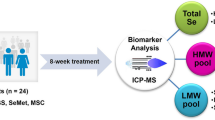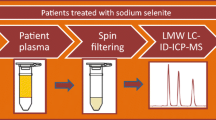Abstract
Se is one of the most investigated essential trace elements in the past years, mostly due to its cancer prevention properties. Nevertheless, the accurate determination of its biologically active species, such as the selenoproteins (SeProt) in human serum, is currently a challenging task. This is because of the lack of appropriate quantification standards, certified reference materials (CRMs), and/or reference measurement methods. Additionally, most of the methods developed so far for the determination of SeProt were applied to the analysis of control (volunteers) serums, which are not available to other laboratories, therefore making methods inter-comparison virtually impossible. We present here for the first time indicative levels of SeProt in a commercially available human serum, namely the BCR-637 CRM with certified level of total Se. The concentrations of selenium associated with glutathione peroxidase (GPx), selenoprotein P (SelP) and selenoalbumin (SeAlb) in this serum were calculated using the results obtained by 13 different analytical methods (literature and non-published data) on the basis of (affinity) high-performance liquid chromatography (AF-HPLC) coupled to inductively coupled plasma-mass spectrometry (ICP-MS). The indicative levels of SeProt in the BCR-637 serum can be used for validation of methods dealing with the determination of these proteins in human serum.



Similar content being viewed by others
References
Navarro-Alarcon M, Lopez-Martinez MC (2000) Sci Total Environ 249:347–371
Hartikainen H (2005) J Trace Elem Med Biol 18:309–318
Whanger PD (2004) Br J Nutr 91:11–28
Hatfield DL, Berry MJ, Gladyshev VN (eds) (2006) Se: its molecular biology and role in human health. Springer, New York
Rayman MP, Goenaga Infante H, Sargent M (2008) Br J Nutr 100:238–253
Jitaru P et al (2008) J Anal At Spectrom 23:402–406
Jitaru P, Cozzi G, Gambaro A, Cescon P, Barbante C (2008) Anal Bioanal Chem 391:661–669
Jitaru P, Roman M, Cozzi G, Fisicaro P, Cescon P, Barbante C (2009) Microchim Acta 166:319–327
Jitaru P, Goenaga-Infante H, Vaslin-Reimann S, Fisicaro P (2010) Anal Chim Acta 657:100–107
Whitford D (2005) Proteins: structure and function. Wiley, New York
Hinojosa Reyes L, Marchante-Gayon JM, Garcia Alonso JI, Sanz-Medel A (2003) J Anal At Spectrom 18:1210–1216
Affinity Chromatography. Principles and methods. Amersham Biosciences, http://www4.gelifesciences.com/aptrix/upp01077.nsf/Content/orderonline_handbooks
Poole CF (2003) The essence of chromatography. Elsevier, Amsterdam
Montaser A (ed) (1998) Inductively coupled plasma mass spectrometry. Wiley, New York
Lobinski R, Schaumloffel D, Szpunar J (2006) Mass Spectrom Rev 25:255–289
Mounicou S, Szpunar J, Lobinski R (2009) Chem Soc Rev 38:1119–1138
Encinar JR, Schaumloffel D, Ogra Y, Lobinski R (2004) Anal Chem 76:6635–6642
Rottman L et al (1994) Fresenius J Anal Chem 350:221–227
Meija J, Mester Z (2008) Anal Chim Acta 607:115–125
De Bievre P, Peiser HS (1997) Fresenius J Anal Chem 359:523–525
Sariego Muniz C, Marchante Gayon JM, Garcia Alonso JI, Sanz-Medel A (2001) J Anal At Spectrom 16:587–592
Rodriguez-Gonzalez P, Marchante-Gayon JM, Ignacio Garcia AJ, Sanz-Medel A (2005) Spectrochim Acta Part B 60:151–207
Bierla K, Vacchina V, Szpunar J, Bertin G, Lobinski R (2008) J Anal At Spectrom 23:508–513
Henderson AR (2006) Clin Chim Acta 366:112–129
ISO 5725-2 (1994) Accuracy (trueness and precision) of measurement methods and results Part 2: Basic method for the determination of repeatability and reproducibility of a standard measurement method
Linsinger TPJ, Kandel W, Krska R, Grasserbauer M (1998) Accredit Qual Assur 3:322–327
http://www.nc3rs.org.uk/bloodsamplingmicrosite/page.asp?id=338
Acknowledgments
This study is a contribution to the iMERA-Plus project (TRACEBIOACTIVITY) funded by the European Metrology Research Programme (EMRP). Dr. Michele Desenfant (LNE) is acknowledged for the scientific discussions.
Author information
Authors and Affiliations
Corresponding author
Rights and permissions
About this article
Cite this article
Jitaru, P., Roman, M., Barbante, C. et al. Challenges in the accurate speciation analysis of selenium in humans: first report on indicative levels of selenoproteins in a serum certified reference material for total selenium (BCR-637). Accred Qual Assur 15, 343–350 (2010). https://doi.org/10.1007/s00769-010-0637-1
Received:
Accepted:
Published:
Issue Date:
DOI: https://doi.org/10.1007/s00769-010-0637-1




